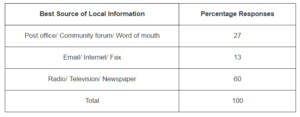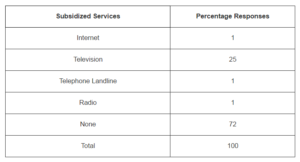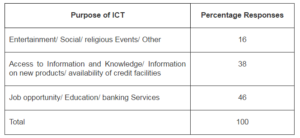Introduction
Lesotho has had some notable achievements in a number of its socio-economic areas, and one of them is ICT infrastructures especially in the urban areas. The major part of Lesotho is, however, comprised of rural areas which are underdeveloped and lack ICT and other modern facilities as compared to urban areas. The intention of the study was also to partly find out to what extent ICT deployment can bridge the digital divide gap between Lesotho’s urban and rural communities in order for ICT to also benefit the rural communities. Conradie, Morris & Jacobs (2003) noted that ICT can bring significant benefits to rural communities in terms of knowledge empowerment and reducing poverty.
Adebgola (2008) elaborates that the importance of ICT to rural communities remains mainly to reduce the digital-divide which describes the gap between those who have adequate access to ICT, and those who have limited or no access due to either socio-economic or geographical reasons. Causes of this digital divide should be understood clearly if sound mitigatory policy prescriptions are to be formulated (Mouton 2001). These arguments in the least force researchers to emphasise on the benefits of ICT in rural areas.
In the rest of the paper literature review is presented in the next section, followed by the research’s theoretical framework. The research methodology and design follows leading to a discussion on the data analysis and results. Lastly some reflections on the research findings and recommendations conclude this discussion.
Background of the Selected Communities
Khubetsoana and Mabote are small rural communities situated in the Southern part of Maseru, the capital city of Lesotho. The total area of these rural communities is less than 80 square kilometers. These rural communities are about 35km apart from each other. Most of the places in these rural communities are mountainous and hilly (Statistics Lesotho 2006). Based on the census data from 2006, the estimated population of these two rural populations combined is less than 10,000 inhabitants (Statistics Lesotho 2009). About 35.7% of the population consists of children under the age of 16. The average household size is 1- 4 persons and nearly 62% of the households are headed by women (Statistics Lesotho 2009). About 2% of the households have access to electricity, 11.3% of houses have access to piped water and more than 60% of the population in these villages is illiterate (Statistics Lesotho 2009). The unemployment rate is high due to the lack of industries particularly in the Mabote and Khubetsoana rural communities. Those who are working are in low paying jobs earning about USD165 per month (Statistics Lesotho 2009). These villages were pinpointed as better, compared to the rest of the other villages in Lesotho in terms of literacy, education and potential ICT infrastructure.
ICT in Lesotho
Despite its poor ICT infrastructure and high levels of poverty, Lesotho recently began to take the necessary steps to promote higher levels of ICT access and usage in its communities and educational institutions. The Kingdom of Lesotho has made ICT establishment and training a key priority in its Poverty Reduction Strategy and National Strategic Development Plan. The plan notes that while Lesotho has made economic progress, it is still among the least developed countries in terms of ICT establishment; use and literacy ranking around number 116 out of 140 countries in 2008 on the world Knowledge Index (KI).
Among its projects, the Government of Lesotho has adopted a National ICT Policy that makes reference and gives priority to the education sector. Over the past few years, a number of ICT projects have been proposed which include The New Partnership for Africa’s Development (NEPAD) eSchools Demo Project, Technology-Enhanced Learning, Community Education Computer Society (CECS), ICT Literacy Programmes, eHealth Initiatives and eAgriculture, development of a web-based Social Welfare Routine Information System (SWRIS) and Lesotho Government Data Network (LGND) (Statistics Lesotho 2010).
ICT Infrastructure in Lesotho
In 2010, the Central Statistical Service, Statistics Lesotho in collaboration with the relevant rural development ministries conducted a survey on ICT infrastructure in the whole of Lesotho including all the rural communities. The survey revealed that most of the rural communities have little or no access to basic ICT infrastructure. Fixed telephone lines are estimated at 6.1 per 100 people with a compliment of 60000 personal computers primarily confined to urban areas as in year 2010. 12% of the households in urban areas as compared to 13% nationally have access to telephone facilities (Statistics Lesotho 2010). The majority of rural communities, about 9% out of the 13% total of village population in Lesotho are still far away from having access to computers and Internet-related technologies. There are currently five internet service providers in the whole country and approximately 43,000 internet users out of the 2.2 million Lesotho population.
The ICT Plan for Lesotho
The ICT plan lays out strategies to improve GDP and reduce unemployment through a radical transformation of its economy. The report on ICT outlines the ICT role in increasing competitiveness of the country through increased efficiency in the production processes and improving access to information and facilitating the establishment of global social networks. ICT is also intended to improve coverage and efficiency of service provision such as health, education and general trade in services (e-commerce). For the ICT sector to develop, and for Lesotho to realize the benefits thereof, an appropriate ecosystem and infrastructure should be developed. As of now, all the above ideas remain plans yet to be implemented given the inadequate financing and having addressed the most important issues peculiar to the livelihood of the Lesotho population as highlighted in the above sections of this study.
Reasons for Underdevelopment in Lesotho Villages
In terms of communities of interest, rural communities refer to those people living in farms or agricultural service centres (Butcher 2002). The reasons for rural underdevelopment are many fold. They range from low priority assigned by the government in developing the infrastructure, lack of interest of private sector to exploit the potential of rural areas, inability of private sector to invest in the development of rural sector and not to mention the low per capita income that exists in these rural areas. Furthermore, only a marginal percentage of the budget is being spent in the development of rural people, especially on education, electricity, proper roads and healthy facilities. These issues have become the main hurdle forcing people in Lesotho’s rural communities to give less preference to the importance of ICT. These issues have also become an impediment to rural people gaining access to, accepting and implementing ICT despite its global pervasiveness and ubiquity.
Pigato (2001) and Caspary and O’Connor (2003) lay out the major causes of rural underdevelopment as lack of: installed ICT compatible equipment, mains power supply, funds for initial capital investment, general operation and maintenance, affordable coverage as well as technical support and computer repair facilities. Pigato (2001) and Caspary and O’Connor (2003) also point out that rural areas have a multitude of problems that create barriers to people owning and using ICTs. Mouton (2001) supports that these are but not limited to: illiteracy, cultural barriers, lack of computer skills, technological know-how, access to computers, computers networks, Internet access, and usage opportunities.
Bridging the ICT Access Gap
To combat the digital divide between the rural and urban communities various ways have been prescribed. Suggestions include creating a monopoly or having a dominant operator with rural service obligations; mobile operators with a rural mandate as well as Universal Access Funds (Pigato 2001). To fight rural poverty using ICT, Chowdhury (2000) and Goldstuck (2002) suggest providing information to households through carrier guidance for example, on the importance of ICT skills to poor young workers. They also suggest improving literacy and numeracy skills of children and giving policymakers access to real-time information on the progress in ICT as well as reducing private and public ICT transaction costs. Considering the fact that ICT environments in most African countries are still developing, ICT diffusion may be difficult to measure without proper knowledge of the harsh realities on the ground. Pigato (2001) noted that ‘reaping the full benefits of ICT adoption and diffusion requires full understanding of ICT applications and their potential benefits’. With these few reflections on the state of ICT in rural areas, the next section briefly discusses the theoretical grounding for this study.
Research Questions
Main Research Question
The main research question that this study seeks to address is: how has ICT contributed to the improvement of Lesotho’s rural people’s lives?
Minor Research Questions
Minor research questions were derived from the main question as follows:
- How can ICT change the socio-economic environment of rural communities?
- What beneficial ICT strategies are in place to improve the effectiveness of ICT use in rural communities?
- What ICT infrastructure exists and/or is needed at the community level?
- What ICT models are being used to ensure that ICT brings maximum benefits to rural communities?
Addressing the Research Questions in Literature
Several issues on how ICT can benefit rural communities have been raised in literature and these were found applicable in answering the research questions. The research questions were also addressed in the research findings section of the study which will be discussed in the sections that follow.
How can ICT change the socio-economic environment of rural communities?
ICT provides access to information that can create earning opportunities, improve access to basic services, or increase the positive impact of education and health interventions by government (Ashley and Maxwell 2004). Herselman and Jacobs (2005) further add that ICT has the potential to avail applied knowledge and information that improves the delivery of services and the good quality of life in rural communities. It can be applied to provide access to new knowledge, upgrade people’s skills for better employment opportunities and improve the quality of essential community services provision (Smith 2000).
What beneficial ICT strategies are in place to improve the effectiveness of ICT use in rural communities?
Mundy and Sultan (2003) highlighted several strategies that can be used to make the use of ICT more effective and sustainable in any rural context. In order to ensure local appropriation of ICT, it is important to decentralize control over the technologies. For ICT use to be integrated into local knowledge and information systems, decentralized control and local ownership needs to be put in place by encouraging active participation. For example, local radio stations recognize that their popularity stems from engendering a sense of proximity with the listening community that other media cannot achieve. Furthermore, to establish the role of ICT in building and supporting the capacity of indigenous knowledge, information sharing methods should be assessed within a local context. ICT should also provide information at reduced costs for it to be accessed by many people including the poor. Lastly, strategies for integrating ICT into rural development need to focus on widespread, cross-sectoral local adoption.
What ICT tools are needed at the community level?
As noted by Grimes (2000) part of government’s public investment programs is to implement modern ICT tools such as internet, wireless technology and e-mail in addition to TV and radio. These can be provided through the introduction of Multi-purpose community centres (MPCC) and telecentres. It is encouraged that they should be subsidized to make them affordable to rural people.
What ICT models are being used to ensure that ICT brings maximum benefits to rural communities?
It is not only sufficient that rural communities have access to ICT for the sake of bridging the digital divide. They must also be trained in the use of these new technologies (Darlington and Scott 2002). Day (2004) noted that ICT provision to the rural community should:
- Embrace community values, participation and coherence.
- Empower community members by enabling them to define their own needs.
- Allow sustained and meaningful dialogue between citizens and service providers in order to align service provision with community needs.
The Theoretical Framework
A theoretical framework is at times regarded as a conceptual framework which provides a theoretical overview and order within the process of research (Goldstuck 2002). This can be used further to provide a theoretical clarification of what researchers intend to investigate as well as enabling readers to see what the research seeks to achieve and how it will be achieved (Darlington and Scott 2002). A theoretically sound conceptual framework has a very strong correlation with a good literature study. The conceptual framework contains key factors, the variables and presumed relationships amongst concepts called theoretical propositions (Hudson 2001). These theoretical propositions also reveal the analytical generalizations that are expected as an outcome of the research study.
Ontologically, the main elements of this study which are researched, that is, ICT and rural communities comprise of similar reality facets such as: households, individuals and technology network elements such as computers, landlines, cell phones, radios, TVs, as well as subjective entities like quality of life. On the other hand, the epistemological view is that the actor-network relationships among these elements produce combined effects of poverty, upliftment, empowerment, income levels and self esteem. All these are reflected in a socially constructed community in which the total effects of individual technologies are reflected as a whole. Methodologically, however, it is noted that the above mentioned elements focus on measuring more immediate and quantifiable indicators, such as total numbers of Internet hosts, households with TVs, cell phones or number of computers per capita and then correlate these to the economic, social, political and other empowerment factors some of which may be affective.
The impact of a technological artifact to a rural society cannot be viewed in isolation to the other elements of the activity system. In this regard, the most appropriate theoretical framework recommendable for this study that reflects the above mentioned elements holistically is the Activity Theory (AT) framework as discussed by Engeström (1999). He mentions that the key characteristic of ICT is its multi-sectoral dimension that makes it affect people’s lives simultaneously in the economic, social and political spheres. In this study the framework applies in that the whole rural community is the unity of analysis and all the six elements of an activity system as highlighted by Engeström (1999) and Amundsen and McAlpine (2009) which are; subject, object, tools, rules, community and division of labour do play a role.
The study therefore uses the AT to explain the coherence of individual actions in a larger social context. The AT guided the development of data collection instruments and at the same time provided the solid theoretical grounding for the data analysis and interpretation required. This stance supports Greswell’s (1994) position that places information (a social construction) instead of technologies at the center of analysis. AT places individuals and their collective capabilities at the centre and leaves ICT to occupy the outer circles of the analysis model. Such a view underscores the fact that ICT is not a means to an end on its own. It can only act to expand the capabilities of the poor to realize improved economic, social, political and cultural opportunities under certain conditions. This methodological stance leads to a discussion on the research design below.
Research Methodology and Design
This study assumed a descriptive method of research which Greswell (1994), describes as a method that gathers information about the present existing condition. It emphasises on describing and verifying formulated hypotheses that refer to the present situation in order to explain it. For this study, the descriptive method was appropriate as it allowed the identification of similarities and differences in the respondents’ answers who comprised of a sample from two rural communities in Lesotho.
Questionnaires were used as the data collection techniques and were mostly delivered to households as research entities instead of individuals because the household assets were mostly identified as the objects of research for example, household’s income and expenditure, and ownership of capital assets. Using simple random sampling, questionnaires were randomly distributed to a hundred (100) households. Random sampling gave each member of the population an equal opportunity to become part of the sample. This method gave all households in the two villages an equal chance of becoming a research participant.
The questionnaires addressed aspects of the study such as: economic status of interviewees, access, use and ownership of ICTs, available ICT services and infrastructure; impact of ICTs on social and economic development; and the purpose and benefits of ICTs. In some cases, the researchers or research assistants filled up the questionnaires on behalf of the target population based on the answers they gave because of the low literacy rates in the two villages. Some of the community members found it difficult to read and write. Of the hundred questionnaires distributed, ninety—one (91) were completed successfully and returned giving a response rate of 91%. The data analysis was done using SPSS V2 (SPSS 2).
Data Analysis and Results
Overall Responses
The results indicated that 57 % respondents came from Khubetsoana village and 43% were from Mabote.
Participants according to Age Groups
Table 1: Percentage of Responses according to Age Group
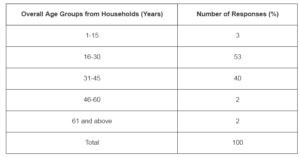
As indicated in Table 1, the majority of respondents, 53% were between the ages of 16-30 years followed by the 31-45 years age group that had 40%. In societies such as rural Lesotho, these age group categories are the most socially and economically active as well most literate age groups of the society.
Income Structure
Table 2: Principal Source of Income
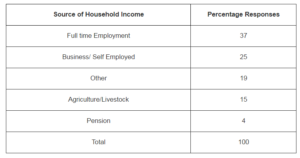
Table 2 indicates that most of the respondents, 37% of the respondents earn a living from full time employment and it is their principal source of income. Self employment included small enterprises in capentry, coblers and spaza shops among others and this comprised of 25% of the respondents.
Table 3: Average Income per month
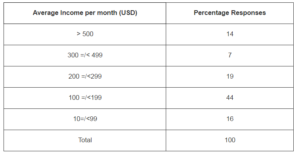
Table 3 shows the average income per month for each household that participated. It indicates that most of the huseholds 44 % of Lesotho villages have income of less than USD 199 per month.
Responses on ICTs
Table 4: Sources of Local Information
As shown in Table 4 above the best sources of local information are radio , T.V and newspaper combined as indicated by 60% of the respondents. This is followed by a 27.47% that use Post Office mail, community forums and word of mouth as second source of local information. Modern ICT tools such as e-mail, internet and faxes (12,09%) are used by a very small propotion of the community.
Figure 1: Ownership of ICTs by Households
Figure 1 above shows that the most provident ICT gadget in among the village households is a radio of which 96.7 % of the respondents own. About 91.2% own a mobile phone and 71.4% own a television set. A very small proportion of the households own personal computers or use internet, email and fax.
Table 5: Frequency of ICTs Usage (%)
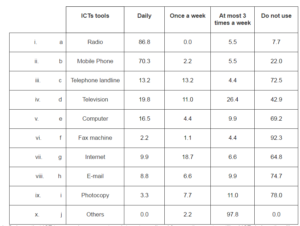
Table 5 shows that ICT types such as computers, Internet, email and fax, are the most unutilized ICTs in Lesotho villages. The most utilized ICT with an 86.8% daily usage rate is on a daily basis is the radio. Interviewees who do not use the radio on a daily basis indicated that it becomes too expensive owing to the cost of batteries which they use to operate the radios since there is no electricity. Mobile phones are also less frequently used on a daily and weekly basis also owing to the costs of recharging of prepaid airtime. Figure 2 below highlights more reasons why some ICTs are less frequently used than others or why they are not used at all.
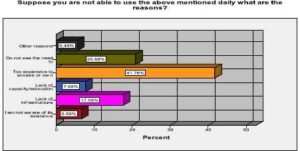
Figure 2: Reasons for Non-ICT Usage
Most households (41.8%) indicated that they do use most of the ICTs because of the high costs involved in using them. 21% indicated that they do not see the need to use ICTs and 18% do not have access to infrastructure required to use ICTs while 8% indicated lack of education capacity.
Table 6: Government Intervention on the Use of ICTs
Table 6 shows that only 25% of the households are aware that TV services are subsidized by government while the majority (71.43%) thinks that no ICT service is subsidized by government. This could be attributed to the lack of knowledge or information of what government contributes to the provision of ICT services.
ICT Infrastructure Available
Figure 3 below shows the available infrastructure in rural areas of Lesotho.
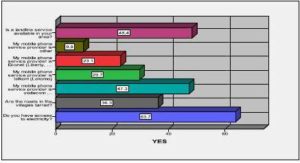
Figure 3: Available Infrastructure
Figure 3 indicates that most of the households 63.7% do have access to electricity and, therefore, they cannot prioritize ICT infrastructure over electricity. Landline infrastructure was the highest showing that 48.4% of the respondents have access to landline phones. The figure also shows traces of mobile infrastructure where VODACOM leads the mobile service providers with 47.3%.
Table 6: Tools Used as Means of Communication
For communication purposes, the majority of the respondents (69%), use radio as shown in Table 6. This is followed by TV with 35% and then mobile phone with 8%. Households indicated they use these means of ICTs to either access or convey information. Table 7 shows the travelling methods that the respondents use to access ICT services.
Table 7: Travelling Method to Access ICT Services
Most of the interviewees indicated that they had to travel less than 1km to access internet, fax and photocopy facilities therefore they can afford to board a bus or go on foot.
Benefits of Using ICTs
Figure 4 and 5 below show the use of internet and mobile phones respectively.
Figure 4: Internet Access
Figure 4 indicates that the majority (25.3%) of respondents use internet for both surfing the net and e- mail services. Respondents indicated that they mainly surf the internet for research and educational purposes and e-mail for business purposes.
Figure 5: Services of a Mobile Phone
Figure 5 above shows that only 19.8% of the interviewees use their mobile phones to surf the Internet or access email. Most households (82.4%) use mobile phones to make and receive calls, followed by short message services (SMS) with about 69.2%.
Table 8: Usage of ICT in the Community
Table 8 indicates that the majority of respondents use ICT in the education, banking sectors as well as in searching for employment opportunities. Figure 6 below gives a summary of ICT benefits as indicated by the respondents.
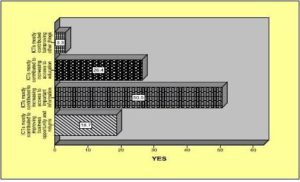
Figure 6: Contribution of ICTs to Improving Living Standards
Figure 7 illustrates that the majority (50.5%) of the respondents believe that ICT tools increase access to important information followed 26.4 % respondents who believe that ICT contribute to increasing access to education. Figure 8 below further highlights the responses of the households with regards to the impact of ICT in their lives.
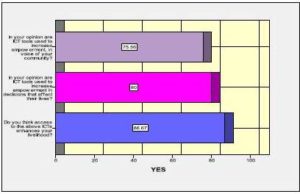
Figure 7: The Impact of ICT to Interviewees’ Lives
Figure 8 shows that 85.67% of respondents felt that ICTs had enhanced their livelihoods. 80% felt that ICTs empowered them in decision making that affect their lives and 75.56% indicated that ICTs gave them a voice. 69.2% of the interviwees identified radios as the tools that have empowered them the most while 51.6% cited newspapers as useful source of information. The task then is to find an ICT enabled method that suppliments newspapers as a source of information. However, there is a 13.19 % group of respondents that use ICT for passing important information faster.
Table 9: The Impact of ICT on People’s Lives
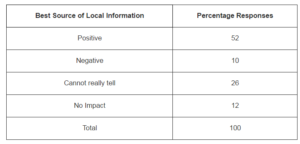
Table 9 indicates that 51.65% of interviewees are of the view that ICT has a positive impact on their lives, whereas 12.02% felt that it does not have any impact at all. ICT is seen as a critically necessary tool in the event of a disaster as well as in information provision. However, 15.10 % indicated that ICT tools are too expensive for them to access, acquire and to use. The next section reflects on the implications of these findings.
Research Findings
The major objective of the study was to reveal the success stories of ICT in rural areas of Lesotho. The study revealed that the most prevalent ICT tools are radio, mobile phone and TV. Out of the total number of people interviewed, 86.67% are positive that ICT can enhance their livelihoods especially in terms of having easier and faster ways access to required and necessary information that affect their lives.
The results indicated different priorities in using ICT services and these were mostly dependent on age and gender. Most young people sampled preferred using mobile phones and computers to access internet, social networks and educational requirements. Women preferred listening to the radio and watching TV. Men on the other hand, preferred listening to news on both radio and TV and watching soccer.
This study has revealed that ICT has the potential to improve rural livelihoods through improving the way business and work is conducted (18.7%), increased access to educational requirements (26.4%) and ease of communication and increased access to key information (50.5%). The analysis also reveals that, with respect to ICT tools ownership, 91.2%, 96.7% and 71.4% of interviewees owned mobile phones, radios and TVs respectively. Of these three, 68.1% of respondents indicated that they use radios to communicate and access information on their community and government issues. Most people still access this information through offline means, such as word of mouth, newspapers and physical visits to government offices. With regard to the availability and usability of infrastructure, 70% of respondents indicated that they did not have access to electricity; as a result, ICT tools in rural areas depend on solar energy, generators and car batteries, which can only be afforded by a selected few.
Despite these potential benefits, several challenges were also revealed in the results which include resistance from users based on cultural or religious beliefs, traditions as well as economic hardship which restrict people from using ICT. The rural community also believes that ICT has impacted negatively (40%) on the society in the form of increased violence and other crimes. They contend that internet and TV expose youth to immoral stuff and that mobile phones can be used in committing crime.
Another barrier is lack of landline phones. About 69% of respondents noted that they did not have landline telephone services in their areas. The lack of electricity and landline telephones make it difficult for individuals in rural areas to invest in telecenters. Wireless networks such as satellite would have been another option but only 19% of respondents confirmed that satellite infrastructure exists in their area; 31% said there was no such service; and 48% of respondents did not know of such as a service. The above findings show that infrastructure is still a major obstacle towards livelihood interventions in rural areas. The infrastructure problem is further aggravated by lack of initiatives to coordinate and make use of existing infrastructure.
Most respondents raised the need for supporting infrastructure such as proper roads, running water and electricity which were mentioned as constraints to ICT development. Another constraint remains the low income that these people earn; most people depend on subsistence agriculture which earns them enough for food and clothes and this leaves ICT tools and services very expensive. The charges for airtime and prices of batteries were provided as examples. The rural communities also highlighted lack of ICT awareness among other issues as a barrier as reflected in the results that about 81% of respondents use radio, 51% use mobile phones and 38% use TV. Only 10% and 6% use email and internet respectively. When asked which tools are best in providing them with local information, most respondents cited radio, word of mouth (30%) and mobile phones (24%).
Research Recommendations and Conclusions
ICT can certainly assist in improving the livelihoods of the rural poor by giving them a voice among other people worldwide and increasing their empowerment. This study revealed that ICTs also empower people in decision making that affect their lives and ICTs like radios remain the most dominant since the early days of technology. The use of ICT has also benefited rural people in managing to pass important information faster.
However, given the variances in the experiences collected, it is sometimes difficult to infer general conclusions. Much in- depth research over a longer time period and with a larger sample representing all ten districts of Lesotho is needed. The unique needs and character of each community make it difficult to multiply initiatives. As can be witnessed if one visits Lesotho rural areas, there are very few projects that can boast to be a success countrywide.
It is recommended that awareness campaigns should take place at all levels. Leaders need to change their approach and behaviour towards ICT and raise a lot of awareness on the opportunities of the information revolution and ICT through policy makers, the private sector and civil society. People should be educated on the importance of ICT knowledge, including ICT tools and how to use them. It was indicated that ICT education should be incorporated in the school curriculum at all levels. It is also recommended that research and analysis be done to determine the role of government as stakeholders especially in meeting up the costs as well as developing alternative solutions. Finally, technology is not the only challenge or the barrier to rural development. It is recommended that the human factor which plays the biggest role and remains the greatest barrier to development be considered. People must take responsibility of thoroughly educating themselves towards ICT. Many unsuccessful projects can be attributed to the human factor rather than to ineffective technology.
References
Adebgola, J. (2008). ‘The Internet. Why? And What for? Thoughts on Information and Communication Technologies for Development in Latin America and the Caribbean,’ Ottawa, 3 (1), 4.
Amundsen, C. & McAlpine, L. (2009). “Learning Supervision: Trial by Fire,” International Journal on Innovations in Education and Teaching, 46 (3), 331—342.
Publisher – Google Scholar
Ashley, C. & Maxwell, S. (2004). ‘Rethinking Rural Development,’ Development Policy Review, 19 (4), 395—573.
Butcher, R. (2002). ‘Development not e-Development,’ Journal of International Development, 14 (1), 1-12.
Caspary, S. & O’Connor (2003). ‘The Role of ICTs in the Development of Sustainable Livelihoods: A Set of Tables,’ Gamos Ltd, DFID, United Kingdom.
Chowdhury, N. (2000). “Information and Communications Technologies and IFPRI’s Mandate: A Conceptual Framework,” [Online]. [Retrieved 18 June 2010], http://www.ifpri.org/divs/cd/dp/ictdp01.pdf
Publisher
Conradie, D. P., Morris, C. & Jacobs, S. J. (2003). “Using Information and Communication Technologies (ICTs) for Deep Rural Development in South Africa,” Information and Communication Technology, 29 (1 & 2), 199-217.
Publisher – Google Scholar
Darlington, B. & Scott, J. (2002). “Researching ICT-Based Enterprise for Women in Developing Countries: A Livelihoods Perspective,” Social Workers’ Report. [Online]. [Retrieved March 2, 2007],http://www.womenictenterprise.org/LivelihoodsResearch.doc
Publisher
Day, P. (2004). “Using Community Informatics to Transform Regions,” Community ICT: Policy, Partnership and practice, Marshall, S., Taylor, W. and Xinghuo, Y. (ed), Idea Group, Melbourne.
Publisher – Google Scholar
Engeström, Y. (1999). Activity Theory and Individual and Social Transformation, Perspectives on Activity Theory, Engestrom, Y., Miettinen, R. and Punamäki, RL. (ed), Cambridge University Press, United Kingdom.
Publisher
Goldstuck, A. (2002). ‘Internet Access in South Africa; Participatory Communication and Adult Learning for Rural Development,’ The Goldstuck report. [Online]. [retrieved March 28, 2007], http://www.theworx.biz/access02.htm. Accessed 12/07/2004.
Greswell, D. (1994a). ‘Sustainable Livelihoods, Environment and Development: Putting Poor Rural People First,’ Sussex Institute of Development Studies press, 18 (3), 14
Greswell, D. (1994b). ‘Empowerment Zones? Women, Internet Cafes, and Life Transformations in Egypt,’ International Journal of Information Technologies & International Development, 23 (1), 9-11.
Herselman, M. & Jacobs, I. (2005). ‘Analyzing the Success of ICT at the Ikageng MPCC in Support of the Itsoseng Community,’ The South African Journal of Information and Communication, 5 (9), 2-5.
Hudson, H. E. (2001a). ‘The Potential of ICTs for Development: Life at Work in the Information Economy; Opportunities and Obstacles,’ ILOW Report, 5 (1 & 2), 6.
Hudson, H. E. (2001b). ‘The Potential of ICTs for Development: Opportunities and Obstacles,’ Telecommunications Management and Policy Program, University of San Francisco. [Online], [Retrieved May 13, 2007], http://www.usfca.edu/fac-staff/hudson/
Google Scholar
Mouton, E. (2001). ‘Poverty and Livelihoods: Whose Reality Counts?,’ Institute of Development Studies, Sussex, 2 (1), 3
Mundy, P. & Sultan, J. (2003). ‘Information Revolutions: How Information and Communication Management is Changing the Lives of Rural People,’ McGraw-Hill, Irwin, New York.
Pigato, M. A. (2001). ‘ICT, Poverty and Development in sub-Saharan Africa and South Asia,’ Africa Region Working Paper Series, 20 (2), 11-13.
Smith, R. (2000). ‘Overcoming Regulatory and Technological Challenges to Bring Internet Access to Sparsely Populated Remote Areas,’ 5 (8), MIT Press. [Online]. [Retrieved April 15, 2007] http://www.firstmonday.dk/issues/issue5_10/smith/.
Statistics Lesotho. (2006). ‘Midyear Population Estimates,’ [Online]. [Retrieved September 03, 2012] http://www.bos.gov.ls/publlications/downloadkeyindicators.asp?
Statistics Lesotho. (20009). ‘Midyear Population Estimates Update,’ [Online]. [Retrieved April 10, 2013] http://www.bos.gov.ls/publlications/downloadkeyindicators.asp?
Statistics Lesotho. (2010). ‘Midyear Population Estimates Update,’ [Online]. [Retrieved May 03, 2013] http://www.bos.gov.ls/publlications/downloadkeyindicators.asp?






